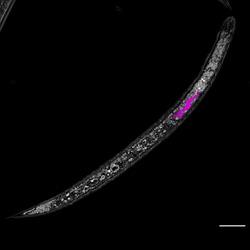Supervisor
Dr Sebastian Eves-van den Akker
Brief Summary
This project aims to understand how parasitic nematodes interact with the first major barrier to infection: the plant cell wall.
Importance of Research
Plant-parasitic nematodes constrain global food security, and in some cases are the dominant pathogens of any kind for a given crop. Understanding how they infect their host has intuitive pathways to impact that are urgently needed.
Project Summary
Across the four independent and ancient evolutionary events that gave rise to plant-parasitism by nematodes, there is only one unifying genetic trait: horizontal acquisition of cell wall degrading enzymes from non-metazoa. This definitive feature of their genomes is remarkable (how does a metazoan acquire genes from bacteria?) and evidently deeply rooted in the evolution of parasitism itself. Nevertheless, comparatively little is known about the biology of these genes compared to other “effectors” (Molloy et al., 2023).
This project seeks to address this fundamentally important knowledge gap, and to characterize the detail of how plant-parasitic nematodes interact with the plant cell wall. We will build on a wealth of resources that we have recently established for the model plant-parasitic nematode pathosystem: Heterodera schachtii – Arabidopsis thaliana (Siddique et al., 2022, Kranse et al., 2021). We will characterize the genetic complement of cell wall degrading enzymes, interrogate their biochemistry, and determine their contribution to plant-nematode interaction as a whole.
What will the successful applicant do?
The successful applicant will learn, deploy, and master the range of requisite skills of a modern molecular biologist from experience members of our group. These include bioinformatic analyses to determine the full complement of cell wall degrading enzymes followed by molecular cloning of nematode cell wall degrading enzymes, exogenous expression, and subsequent protein purification from bacteria. They will use this protein to: i) generate antibodies to determine the spatio-temporal deployment of the enzyme(s) during parasitism, and ii) to characterize the specific biochemical reaction they catalyse. Finally, they will use reverse genetic approaches to determine the role of these enzymes in the infection process.
References
- Molloy, Beth, Thomas Baum, and Sebastian Eves-van den Akker. "Unlocking the development-and physiology-altering ‘effector toolbox’ of plant-parasitic nematodes." Trends in Parasitology (2023).
- Siddique, S., Radakovic, Z.S., Hiltl, C. et al. The genome and lifestage-specific transcriptomes of a plant-parasitic nematode and its host reveal susceptibility genes involved in trans-kingdom synthesis of vitamin B5. Nat Commun 13, 6190 (2022). https://doi.org/10.1038/s41467-022-33769-w
- Kranse, Olaf, et al. "Toward genetic modification of plant-parasitic nematodes: delivery of macromolecules to adults and expression of exogenous mRNA in second stage juveniles." G3 11.2 (2021): jkaa058.

